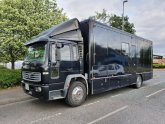Mission : to build me a stand alone self sufficient solar powered system for off-grid wild camping situations.
I'm seeking all the advice i can get to get it right first time round. I am almost autistic when it comes to perfection and with a decent budget available i want good components in the fold. I've not worked out load demand yet fully and instead am working back to front in so much as maxing out on the number of panels i can install on the roof. I have some new Dimplex 230w panels coming my way and availability to fit 8 of them up top. I will fabricate an articulating mechanism using 24v actuators to maximise panel function. Battery bank will be 24v.
What i seek is information to construct a layout drawing in the first instance so i can visualise the finished job before i start handing over the hard earn't loot..!!!!
Will, if your reading this feel free to chime in and share some of your knowledge as well as other members
Here's my truck, a little old and tired she's getting a full revamp, that roof is fully chequerplated and ready for solar....!!!!

I'm seeking all the advice i can get to get it right first time round. I am almost autistic when it comes to perfection and with a decent budget available i want good components in the fold. I've not worked out load demand yet fully and instead am working back to front in so much as maxing out on the number of panels i can install on the roof. I have some new Dimplex 230w panels coming my way and availability to fit 8 of them up top. I will fabricate an articulating mechanism using 24v actuators to maximise panel function. Battery bank will be 24v.
What i seek is information to construct a layout drawing in the first instance so i can visualise the finished job before i start handing over the hard earn't loot..!!!!
Will, if your reading this feel free to chime in and share some of your knowledge as well as other members
Here's my truck, a little old and tired she's getting a full revamp, that roof is fully chequerplated and ready for solar....!!!!




